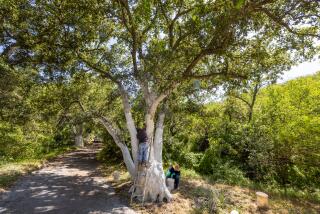Tiny bug takes a large toll on forests across Europe
- Share via
CASTINCAL, PORTUGAL — Manuel Coimbra watches in silence, his hands on his hips, as a lumberjack saws down one of his pine trees to stop a killer bug that experts say could wipe out large belts of European woodland.
The dense forests that blanket the hillsides of this rural area of west-central Portugal are the latest international conquest for the pest, which has caused ecological catastrophes in East Asia. Thousands of trees here are already dead, according to locals.
“It makes me sad,” Coimbra says, leaning against a vehicle on a shady dirt road as experts bag shavings from the felled tree for testing at a local lab.
“Future generations probably won’t know what we’re talking about when we tell them about pine forests. We’d better start taking some photographs to show them,” says Coimbra, a soft-spoken middle-aged man who owns about 20 acres of local pine forest.
His land is on the front line of Europe’s attempt to check pine wilt disease, which is spreading out of control in this southwestern corner of the continent and is a menace from Scandinavia to Italy and Greece. Two species of pine are susceptible -- maritime pine, which accounts for almost one-quarter of Portugal’s forest, and Scots pine, the most widespread pine species in Europe, which is frequently used for Christmas trees.
The concerns are not just environmental. Europe is the world’s largest importer and exporter of forest products.
The European Commission last month tightened restrictions on the export of Portuguese pine, which must be disinfected and given a clean bill of health before leaving the country. The bug, called a nematode, is a worm invisible to the naked eye which swarms through a pine tree’s innards and kills it within weeks by choking off the flow of sap. It gets around by hitching a lift in the respiratory system of a flying beetle that looks a bit like a cockroach.
The beetle is believed to have arrived in Portugal in a ship’s cargo from East Asia, where in the 1970s the nematode almost wiped out Japan’s vast pine forests. In the following decade, major outbreaks were recorded in the pine forests of China, Taiwan and Korea.
Pine wilt disease is endemic to North America. However, losses there are not widespread, in large part because of different climatic conditions where pine is found. The nematode is fonder of the warm conditions in southern Europe.
Coimbra’s felled tree bore the telltale signs of infection: color drained from the needles, which turned brown and then dropped off, leaving the bare stick of a doomed tree.
The nematode was first detected in the Setubal region south of Lisbon in 1999. About 340,000 trees died there in just two years. Experts suspect the beetle arrived in wooden crates or pallets at a nearby port after Portugal rolled down its flag in Macau and handed the territory back to Chinese rule that year.
Despite official efforts to halt its spread, including the felling of pines over 320,000 acres to create a containment belt two miles wide and more than 60 miles long, the nematode has marched on.
In April, it turned up in central Portugal, more than 120 miles north of the initial outbreak. The only way to curb its progress is to cut down infected trees and burn them.
“It’s really bad,” says Vasco Campos, head of a local wood producers’ association called Caule. “You spot new [infected trees] every day.”
Experts reckon unscrupulous logging firms transported infected wood illegally from Setubal to the central region. Locals here complain there is little compliance with laws regulating timber transport and little enforcement by authorities.
The Agriculture Ministry in Lisbon did not reply to requests to view the measures being taken.
Manuel Mota, an expert at Portugal’s University of Evora and co-author of a recent book called “Pine Wilt Disease: A Worldwide Threat to Forest Ecosystems,” says the bug is a fearsome enemy.
“The disease is devastating,” Mota says. “In scientific circles we say, ‘Nematodes are forever.’ You’re not going to be able to eradicate it. It’s impossible.”
More to Read
Sign up for Essential California
The most important California stories and recommendations in your inbox every morning.
You may occasionally receive promotional content from the Los Angeles Times.












